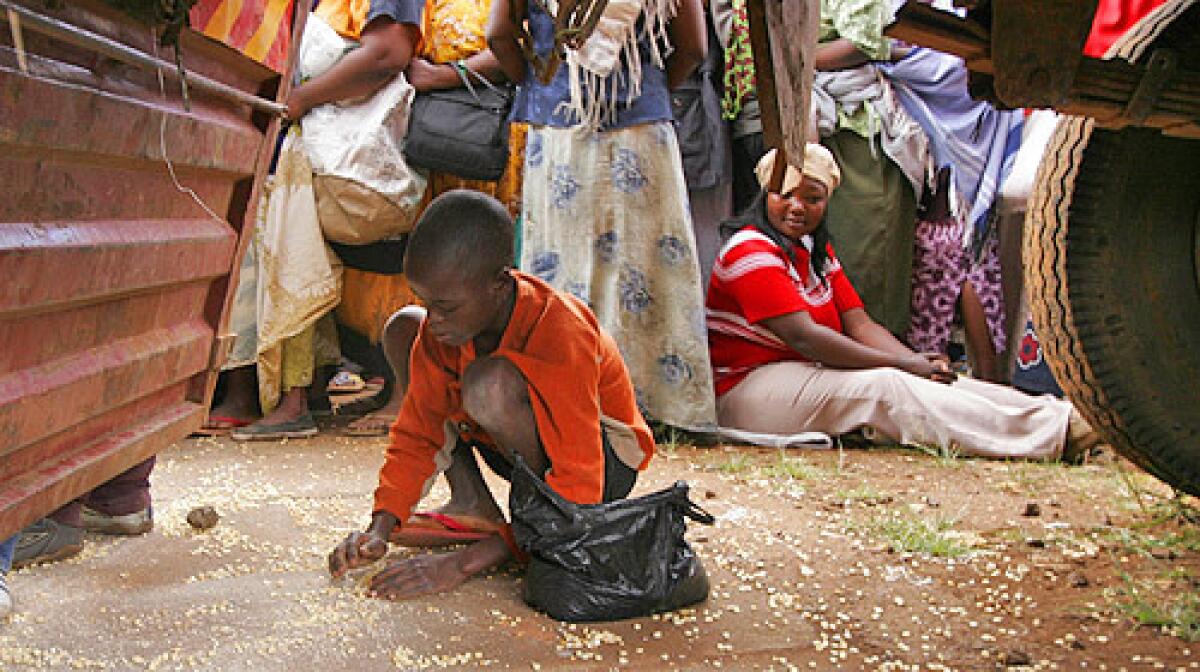In Africa: from very little to almost nothing

- Share via
NDZANGU, SWAZILAND — The new prices in the small, tatty shop went up a few weeks ago, scrawled on scraps of blue cardboard beneath the broken plastic clock. Some villagers stared in silent shock. Others wanted to know why the price of everything had increased.
The shop assistant, Ngondile Ngcamphalala, 23, didn’t have much of an answer.
“I don’t know why. I always tell them that the prices have gone up at the warehouse where we get things from,” she shrugged, an old battery radio buzzing drowsily in the background.
Everything that decides the prices is beyond the villagers’ control: the lack of rain, spiraling international prices, increasing global demand, the collapsing rand currency in neighboring South Africa.
The latest price increases were by two emalangeni, or about 25 cents. Around here, that’s a fortune.
According to the United Nations, about 69% of Swaziland’s population lives below the poverty line; a quarter of the population depends on food aid. Meantime, King Mswati III, Africa’s last absolute monarch, has 13 wives and a fleet of luxury cars, all paid for by the state.
Njabuliso Samedze, 31, sits on a worn mat in the shade, nursing a baby, Nomphilo, whose belly is severely distended, a sign of malnutrition. Two skeletal puppies wander in the dirt.
She, her husband and three children rely on aid from the U.N.’s World Food Program. Her husband, Musa, a builder and farmer, earns about $20 a month growing cotton and collecting payments for houses he has built. But he has not built a home since 2001 because no one can afford one.
Samedze buys cornmeal, soap, salt, cooking oil and paraffin for lamp oil. But she has cut back on oil and paraffin.
“We stopped buying rice. We used to buy sugar, but not anymore,” she says. “The prices are decided by shop owners, so there is nothing we can do when the prices go up.”
Eastern Swaziland hasn’t had good rains since the 1990s, crippling agriculture.
The poor depend on the maize harvest. “Any increase in [the price of] maize will make life much more difficult for very vulnerable people,” said Richard Lee, spokesman for the World Food Program in Johannesburg, South Africa.
As a policeman’s wife, Zodwa Ndzimande, 68, had no fear of poverty. But after her husband died, she found that his monthly pension kept shrinking. Now she too relies on World Food Program handouts, and when she runs short she has to barter for food.
Ndzimande sits outside her rundown thatched hut, rolling plant fibers to make string to sell. She also collects and sells wild fruit. The items bring her about nine cents a day.
A short walk from the Ndzangu shop, one house exudes a satisfied, well-to-do air, with curtains swaying in the windows. But inside, retired sugar worker Wilson Nxumalo is in despair.
“We can’t buy rice, meat, things like that,” he said.
“I even sold off my last cattle at the beginning of the year, just to buy mealies [corn meal].”
“It worries me a lot,” he said. “How am I going to do this? What will I do?”
More to Read
Sign up for Essential California
The most important California stories and recommendations in your inbox every morning.
You may occasionally receive promotional content from the Los Angeles Times.










